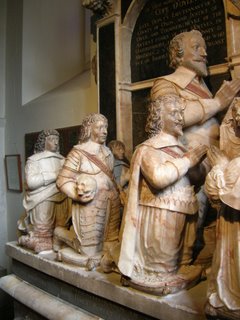
With Spring finally arrived, out for a walk near Henley on Thames, watching red kites playing in the wind above Fawley, and then descending down to Hambleden. Here the stream, confidently shown on the OS map, has not run for two years; a local told me that two years of significant rainfall was needed for the stream to run again, so low has the water-table in the Chilterns sunk.
In the church at Hambleden, a monument to Sir Cope D’Oyley (1571-1633) and his wife Martha, ‘who received the crown of glory in the year of Grace 1618’. She died shortly after the birth of their 10th child, and 5th little girl: for they had ‘lived together in inviolated bands of Holy Wedlock 22 years, and multiplied themselves into five sons and five daughters, viz. John, James, Robert, Charles, Frances, Martha, Mary, Dorothie, Elizabeth & Joan.’
As is usual, the boys kneel in front of their Father, the girls in front of their mother, both sets facing one another, as the parents face one another in prayer.
Here are the verses beneath, first for Sir Cope:
Ask me not who’s buried here
Goe ask the commons, ask the Shire
Goe ask the Church, they’l tell thee who
As well as blubbered eyes can doe
Goe, ask the Heraulds, ask the poore
Thine ears shall heare enough to ask no more
Then – if thine eye bedew this sacred urne
Each drop a pearle will turne
T’adorne his Tombe, of if thou canst not vent
Thou bringst more marble to his Monument.
And again, for Martha:
Woulds’t thou, reader, draw to life
The perfect copy of a Wife
Read on, & then redeeme from shame
That lost, that honourable name
This Dust was once in spirit a Jael
Rebecca’in grace, in heart an Abigail
In works, a Dorcas: to the church, a Hanna
And to her spouse, Susanna
Prudently simple, providently wary
To the world a Martha, to heav’n, a Mary.
This was a family with connections to literature: Martha was the sister of the poet Francis Quarles. The verses might be locally written – that sounds to me like a
They had 10 children, four of them dying young. John, the eldest boy, was a royalist, while Charles, the fourth son, fought for the other side, commanding Lord Fairfax’s Life Guard at the Battle of Naseby, where he offered the bare-headed Fairfax – a wildly courageous man from a military family – his own helmet in the midst of the battle. The two brothers seem to have come close to fighting one another in smaller local actions, but both survived the war.
I post an image of the elder sons. The Church guide asserts that John, the eldest, and James, the second brother, are dressed as Cavaliers, while the three younger sons are dressed as Puritan roundheads. The first thing about John is that he is a mature man, scaled at two thirds the size of his father, that was the conventional way to sculpt a tomb like this. He is barbered and dressed for court, his next brother ‘died young’, but was presumably intended for the army, for he is in 17th plate armour. The last three boys are indeed in plainer attire, the simple linen flap falling down square over the shoulders, and in two shorter lozenge shapes at the open front. But how was this done? How could a monumental mason carve in alabaster in 1633 the outward form of the boys’ political persuasions in the 1640’s? No, the three younger sons are just in the neutral attire of younger sons of an Oxfordshire gentleman, their careers neither settled nor projected.
I usually tell my students – the young women at least – what their reproductive career might have been had they been born 400 years before. None of them remotely contemplates that 5-7 children average. Martha came from a Puritan family of 8 children, her brother Francis and his wife managed 18. What nets of kinship they must have had!
No comments:
Post a Comment